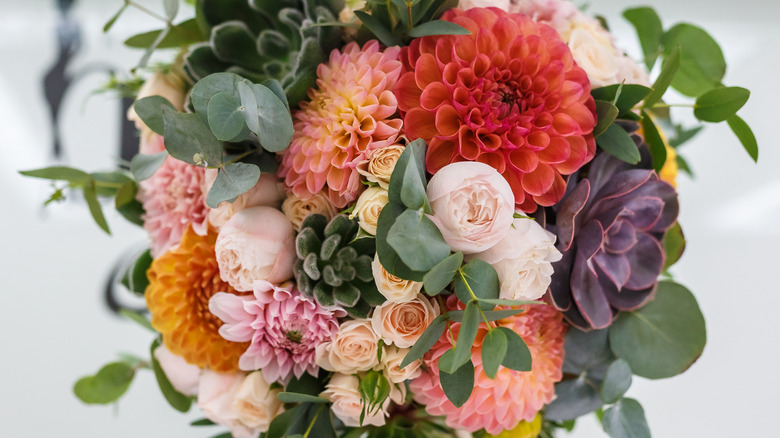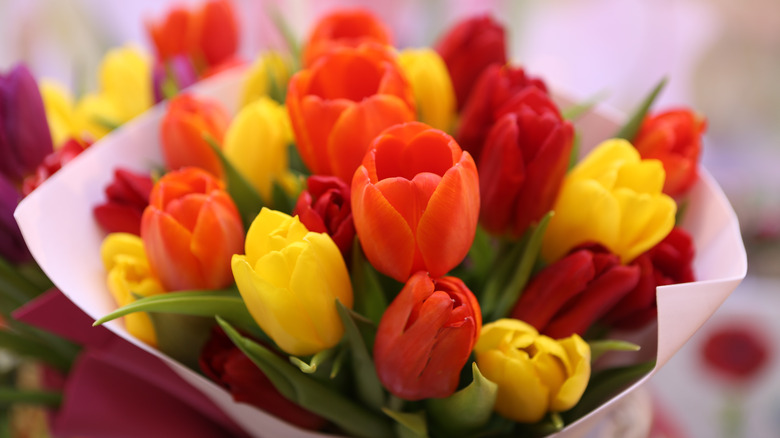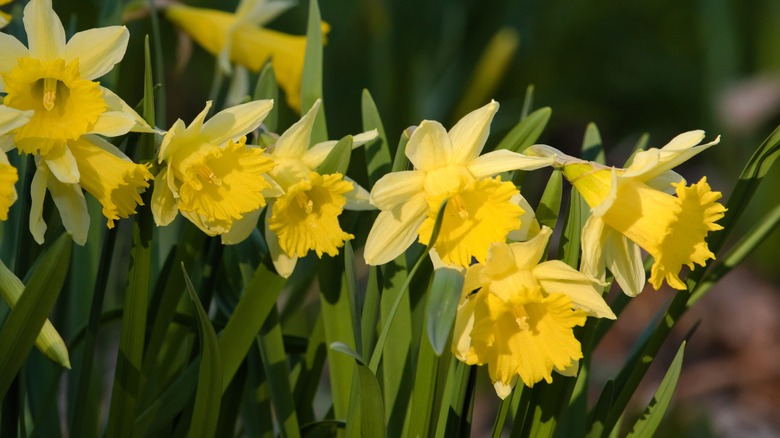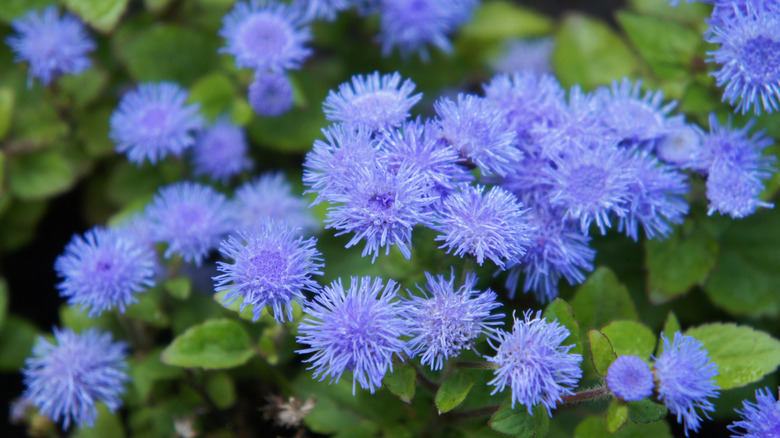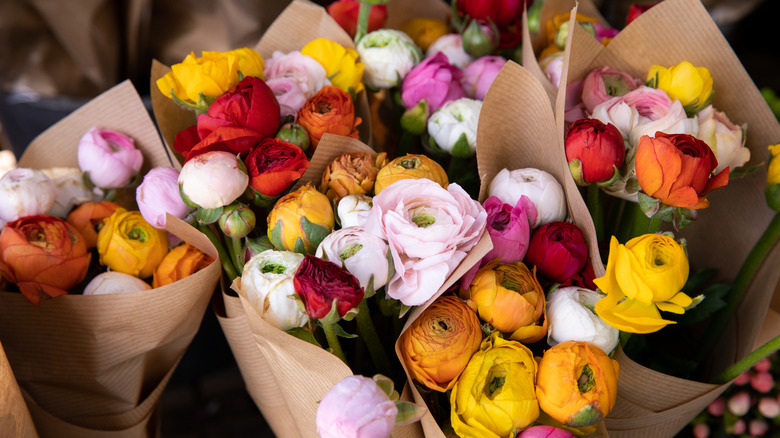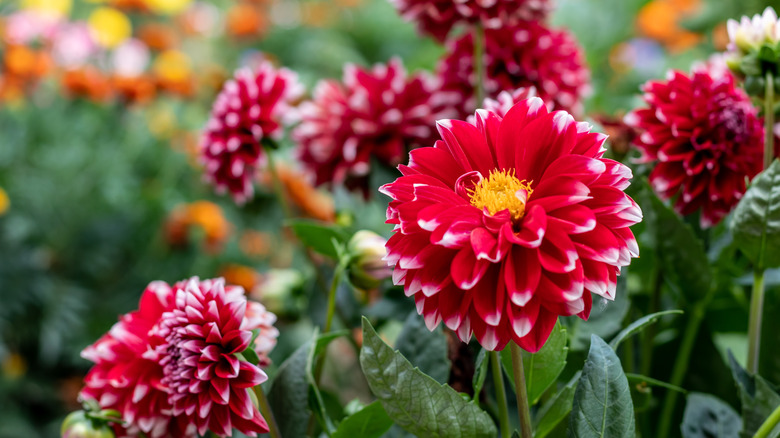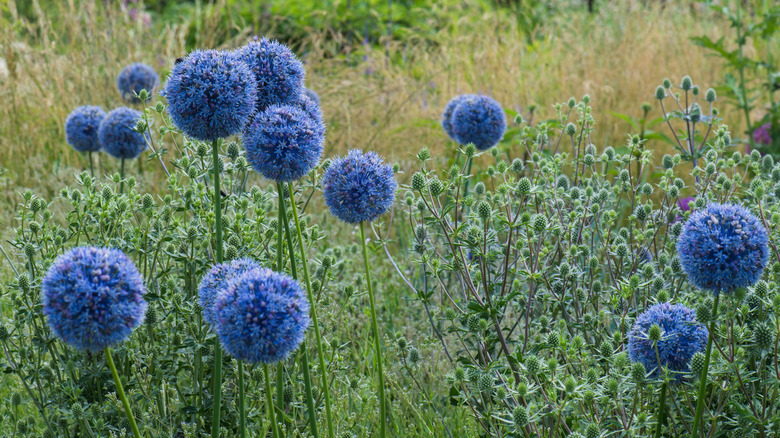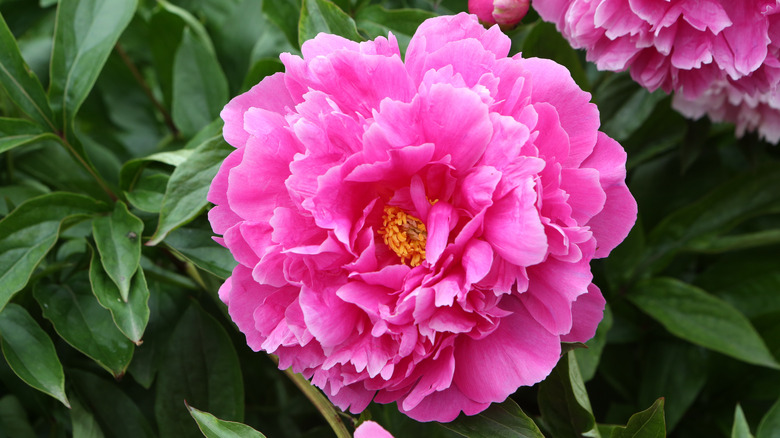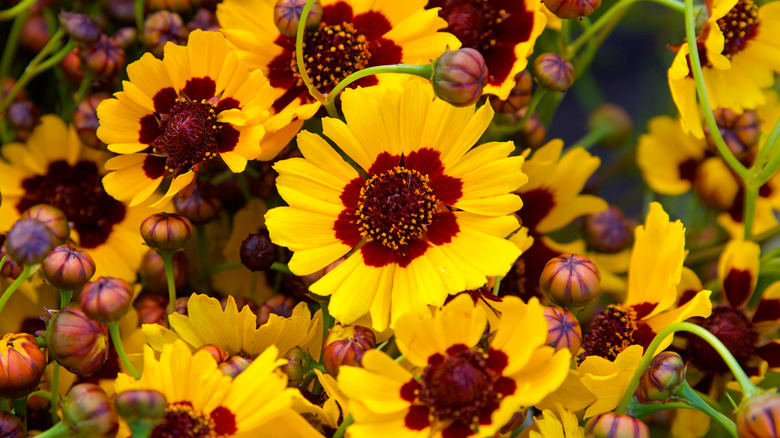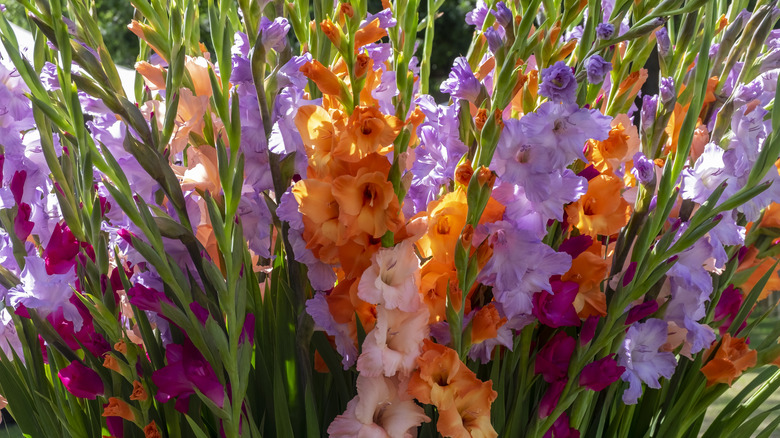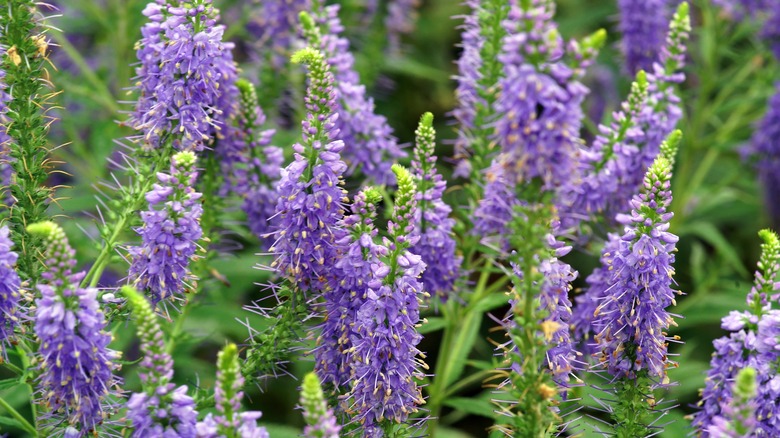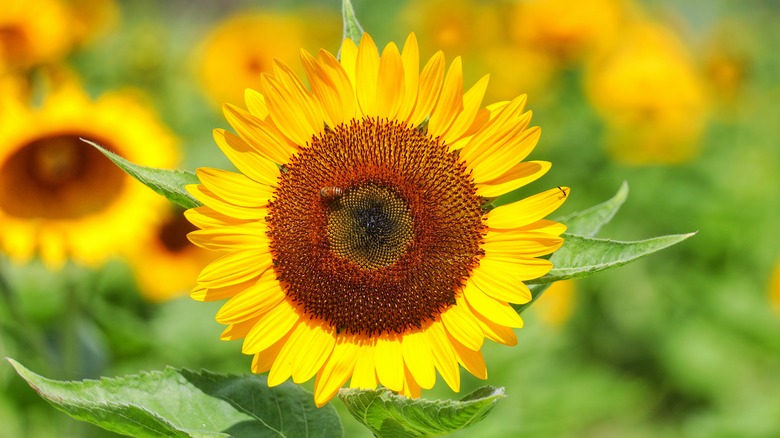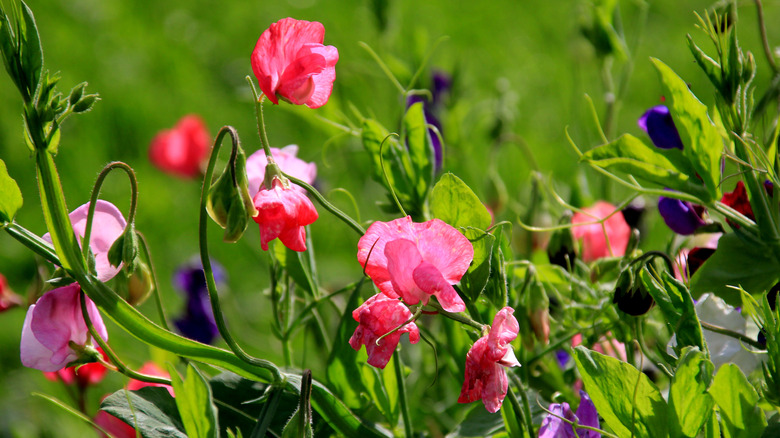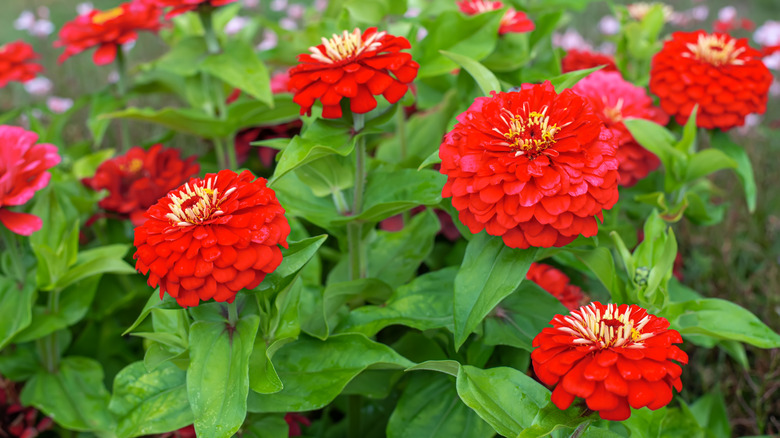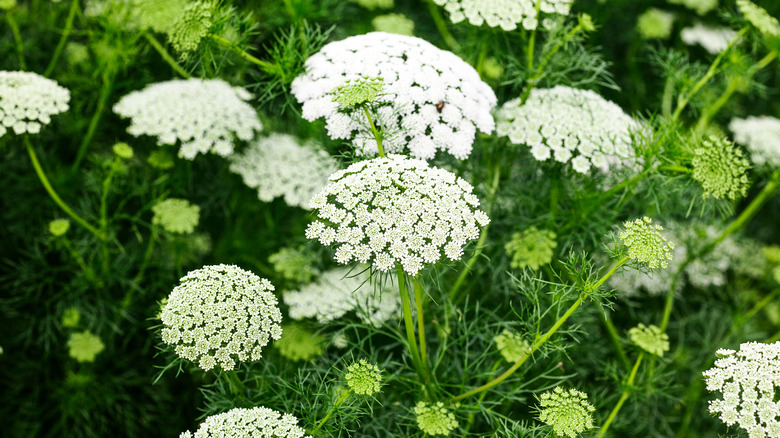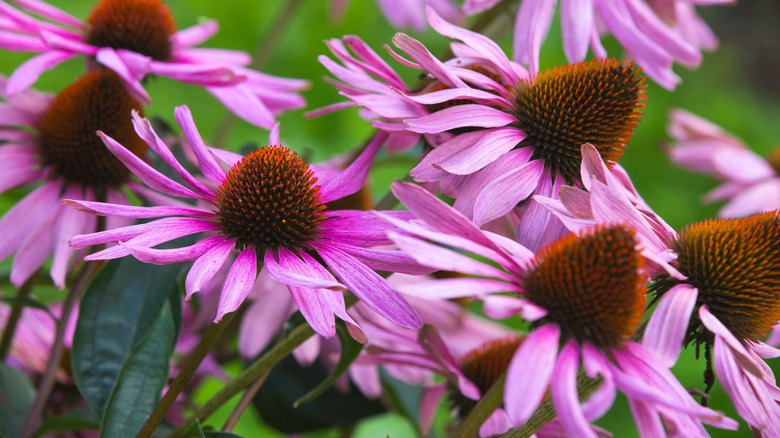15 Flowers Perfect For A Cut Flower Garden
Buying a fresh bouquet of flowers for your home every month or every week isn't sustainable for most people. Instead, some savvy gardeners are growing their own cut flower gardens in their backyards. Cut flower gardens are an economical way to save money, support native pollinators, and gather healthy flowers to use all over your home, as pointed out by Thistle Down Farm. Most flowers that are commonly used in these types of gardens are relatively straightforward to grow and care for. Many, depending on the USDA growing zone you're planting in, are low-maintenance and won't require special treatment such as protection, frequent watering, or unique soil.
When you begin to look into cut flower options for your garden, the choices are seemingly endless. There are quite a few species with sturdy stems and large colorful blooms. Planning out this garden can take some hard work, but you can filter out many of these options when you know your climate, your care schedule, and when you want these plants to blossom. As you take a look at this modest collection of flowers, consider which will fit best into your lifestyle and aesthetic.
1. Tulip
A bulbous perennial, the common tulip (Tulipa spp.) is regarded for its spring-blooming cup-shaped flowers that happen to be edible. This flower, which has been naturalized in many areas across the globe, is remarkably cold hardy and it can be grown as an annual or a perennial, as mentioned by North Carolina State Extension.
Bloom Season: Spring
USDA Growing Zone: 3 to 8
Growing Conditions: Full sun
Soil Type: Fertile, organically rich, and well-draining
Size: 4 to 52 inches tall and 6 to 9 inches wide
2. Daffodil
Daffodils (Narcissus pseudonarcissus) are widely recognized for their yellow blossoms that feature a trumpet surrounded by six petals. However, there are many other varieties of daffodils that look a little different. You can grow this flower in not only yellow, but also white, pink, orange, and cream, and, according to Longfield Gardens, each of these variations comes in a few flower styles such as split-cups, large cups, and doubles.
Bloom Season: Early to late spring
USDA Growing Zone: 3 to 8
Growing Conditions: Full sun to partial shade
Soil Type: Well-draining
Size: 6 to 16 inches tall
3. Ageratum
The flossflower (Ageratum houstonianum) is one of the most popular species in the Ageratum genus. This unique flower can add flair to any flower arrangement that needs a pop of blue or lavender. The soft, feather-like flowers grow quickly and last all season for your pleasure. As per the University of Wisconsin-Madison, the best care for the flossflower includes evenly moist soil, a location that receives full sun, and regular watering.
Bloom Season: Late spring to late fall
USDA Growing Zone: 2 to 11
Growing Conditions: Full sun
Soil Type: Moist and well-draining
Size: 6 to 30 inches tall
4. Persian buttercups
Persian buttercups (Ranunculus asiaticus), native to parts of Africa, Asia, and Europe, are an extremely beautiful flowering species commonly used in cut flower gardens. Flowers on this plant can appear white, yellow, pink, red, or purple, and they typically last from May to June, as told by the Missouri Botanical Garden. In addition to cutting gardens, Persian buttercups also do well in border gardens and containers.
Bloom Season: Spring to summer
USDA Growing Zone: 8 to 10
Growing Conditions: Full sun
Soil Type: Well-draining
Size: 1 to 2 feet tall and wide
5. Dahlia
With hundreds of cultivars to choose from, dahlias (Dahlia spp.) are among the best options for cut flowers. The University of Georgia tells us that this flower can be challenging to raise, but with some specific care, you can have wonderful blooms in a few colors. Make sure when you're ready to cut your dahlias that you only cut them during the early morning or late in the evening.
Bloom Season: Summer
USDA Growing Zone: 8 to 11
Growing Conditions: Full sun
Soil Type: Loose, evenly moist, and well-draining
Size: 1 to 6 feet tall
6. Ornamental onion
Blue globe onion or ornamental onion (Allium caeruleum) is a flowering plant related to garlic, shallots, and common onions. Their blooms can be valuable in a flower arrangement as they show off a round shape and sky blue petals, as described by the Missouri Botanical Garden. Keep in mind that this bulbous perennial enjoys somewhat dry soil, and it is drought-tolerant. Overwatering can lead to a quick death.
Bloom Season: Summer
USDA Growing Zone: 4 to 8
Growing Conditions: Full sun
Soil Type: Rich and well-draining
Size: 1 to 2 feet tall and 6 to 12 inches wide
7. Peony
Itoh peonies (Paeonia Itoh) are one of the earliest bloomers in this collection, making them the perfect option for spring bouquets mixed with tulips and daffodils. This plant's large semi-double blossoms, which are sweetly scented, are normally 8 inches in diameter, according to American Meadows. Remember that peony plants can grow somewhat large. Each bush should be planted about 3 feet apart in holes that are at least 1 foot below the soil level.
Bloom Season: Early spring
USDA Growing Zone: 5 to 7
Growing Conditions: Full sun
Soil Type: Moist and loamy
Size: 3 feet tall and wide
8. Coreopsis
The delicate flower coreopsis (Coreopsis spp.) is most often identified by its eight-petaled blossoms and its upright, clumping growth habit. As per Costa Farms, this drought-tolerant, sun-loving perennial does just as well in a cut flower garden as it does in a pollinator garden. With proper care, the coreopsis plant will fill your flower beds with color and butterflies.
Bloom Season: Spring and early summer
USDA Growing Zone: 4 to 9
Growing Conditions: Full sun
Soil Type: Well-draining
Size: 6 inches dwarf varieties to 2 feet tall
9. Gladioli
Gladioli plants (Gladiolus spp.) are summer-blooming bulbs that produce tall flower spikes filled with delicate blooms that may be white, pink, red, yellow, lavender, purple, or bi-colored, as described by Longfield Gardens. In a cut flower garden, you should wait to pick your gladioli until the flowers are open. Usually, this plant blooms in the late summer and the flowers can last well into the fall.
Bloom Season: Late summer
USDA Growing Zone: 7 to 10
Growing Conditions: Full sun to partial shade
Soil Type: Fertile and well-draining
Size: 3 to 4 feet tall
10. Veronica
Also known as speedwell, Veronica (Veronica spp.) is a genus of more than 250 species and even more varieties, as noted by the North Carolina Extension Gardener Plant Toolbox. This large group of flowering plants often produces spiky, erect flowers that are blue, purple, pink, or white. They bloom for most of the year, and they look great in a variety of garden settings.
Bloom Season: Summer, fall, and spring
USDA Growing Zone: 3 to 9
Growing Conditions: Full sun to partial shade
Soil Type: Evenly moist and well-draining
Size: 1 to 4 feet tall and 1 to 2 feet wide
11. Sunflower
Sunflowers (Helianthus annuus) are well-known for their tall stalks and large flowers, which can be more than 7 inches in diameter, says California Native Plant Society. This sun-loving annual is often used in bouquets and flower arrangements in the fall where they are paired with other late bloomers such as dahlias and marigolds.
Bloom Season: Summer to fall
USDA Growing Zone: 2 to 11
Growing Conditions: Full sun
Soil Type: Rich, loose, and well-draining
Size: 5 to 10 feet tall and 2 feet wide
12. Sweet pea
Sweet pea flowers (Lathyrus odoratus) are climbing annuals that can grow in a variety of conditions if they're planted in fertile and organically rich soil supplemented with regular fertilization, as told by the Royal Horticultural Society. The plant's fragrant blossoms appear toward the end of the growing season. Typically, they are grown to be cut for flower arrangements, however, you may see them planted in wall side borders and informal gardens.
Bloom Season: Summer and fall
USDA Growing Zone: 2 to 11
Growing Conditions: Full sun to partial shade
Soil Type: Fertile and well-draining
Size: 5 to 8 feet tall
13. Zinnia
Zinnias (Zinnia spp.) are hot-weather flowers that are just as attractive to humans as they are to pollinators like bees and butterflies. This popular genus of plants in the aster family is known for low-maintenance care requirements and their ornamental value, as per Penn State Extension. Taller species of zinnias such as Z. elegans are best for use in cut flower gardens, as their large flowers sit on tough, upright stems.
Bloom Season: Summer
USDA Growing Zone: 9 to 11
Growing Conditions: Full sun
Soil Type: Well-draining
Size: 6 inches to 3 feet tall
14. Lace flower
The lace flower (Ammi majus) is a popular filler flower in floral arrangements and flower bouquets. They grow on tall stems, so the flowers are easy for florists to incorporate into any presentation. Thankfully, these spring-blooming annuals are low-maintenance, and they can survive in several growing conditions, according to North Carolina State Extension.
Bloom Season: Spring
USDA Growing Zone: 2 to 11
Growing Conditions: Full sun
Soil Type: Moist and well-draining
Size: 3 to 6 feet tall and about 1 foot wide
15. Coneflowers
Coneflowers (Echinacea spp.) are a hardy genus of perennial flowers that are native to the U.S. Echinacea purpurea is a popular option for gardeners, and it is commonly referred to as the purple coneflower. This species gives way to a few different cultivars that all feature tall stems and wide flowers, explains Clemson Cooperative Extension.
Bloom Season: Summer to fall
USDA Growing Zone: 3 to 9
Growing Conditions: Full sun to partial shade
Soil Type: Moist and well-draining
Size: 4 feet tall and 2 feet wide
